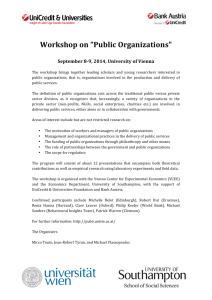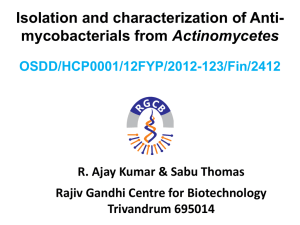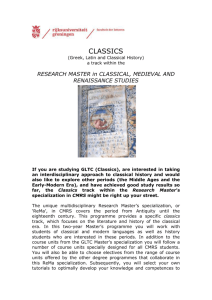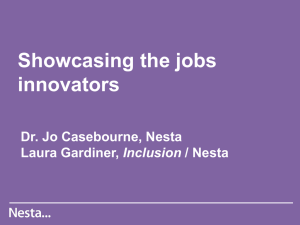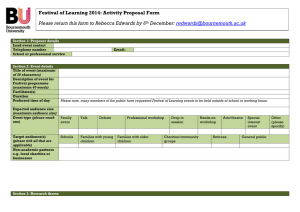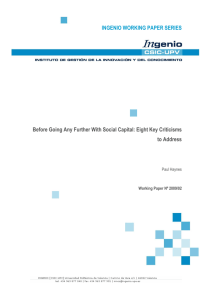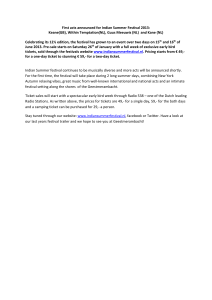REMA_presentation_ECM_AR_def
advertisement
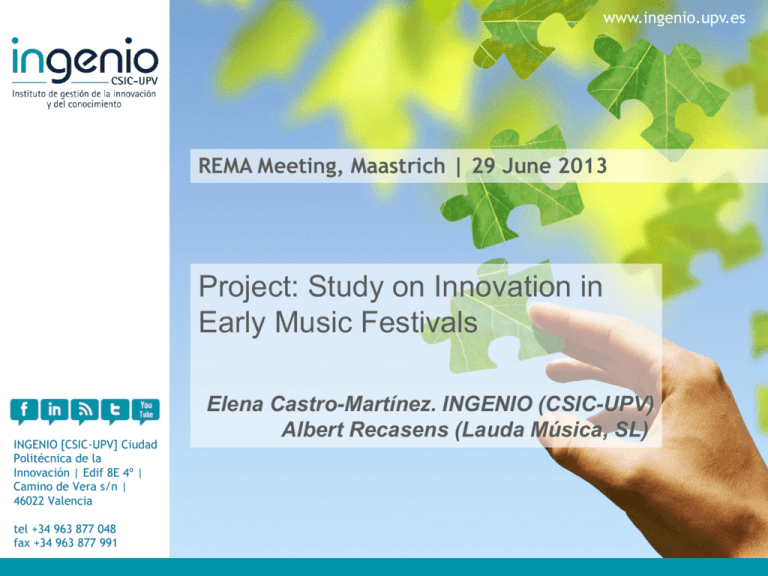
www.ingenio.upv.es REMA Meeting, Maastrich | 29 June 2013 Project: Study on Innovation in Early Music Festivals INGENIO [CSIC-UPV] Ciudad Politécnica de la Innovación | Edif 8E 4º | Camino de Vera s/n | 46022 Valencia tel +34 963 877 048 fax +34 963 877 991 Elena Castro-Martínez. INGENIO (CSIC-UPV) Albert Recasens (Lauda Música, SL) INDEX 2 11) About Us 22) How we work 33) What we do (our research line) 44) A brief description of the concepts of innovation that we are using 55) …. and their application to cultural sector 66) What we aim in the project 77) What we expect from REMA and its members 88) Schedule 99) What we can offer to REMA and its members ABOUT US The Spanish National Research Council (CSIC) is the biggest public research organization in Spain: 126 institutes 14,050 CSIC staff + 4,605 other institutions staff (joint centres) 804 M€ budget 3,628 on going R&D projects (2011 data) INGENIO [CSIC-UPV] 22 researchers 7 PhD students 10 support staff 3 students INGENIO is a member of EuSPRI Forum Main research line: innovation studies 3 HOW WE WORK INGENIO (CSIC-UPV) aims to contribute to the best understanding of the innovation processes as well as science and innovation policies which can improve it. We also aim to contribute to innovation culture and to disseminate innovation concepts We are a multidisciplinary group of specialists in innovation studies 4 scientific excellence + social relevance We cooperate with other specialists and entities OUR RESEARCH LINE 5 Starting: Study of interactions of humanities and social science's CSIC research groups with socio-economic agents (2004) Identifying very interesting cases of interactions between humanities’s research groups and cultural institutions [one of them, musicology] Study of innovation processes in cultural sector: Archeology (with INCIPIT) Historic heritage (with IAPH) Documentary ‘ s production Early music production [with Lauda Música] INNOVATION CONCEPT 6 AN INNOVATION is the implementation of a new or significantly improved product (good or service), or process, a new marketing method, or a new organisational method (Oslo Manual, OECD 2005) TYPES OF INNOVATIONS BY NATURE [1] 7 PRODUCT INNOVATION: significant differences in purpose, in performance [functional concept, presentation], in technological concept [raw materials, components, technological characteristics] of the product compared to existing ones. PROCESS INNOVATION: adoption of production methods technologically new or significantly improved, including methods of product delivery. The definitions of product innovation focus on functional or user changes and, thus, do not include changes in the meanings, aesthetics or content produced in the area of culture. TYPES OF INNOVATIONS BY NATURE [2] 8 MARKETING INNOVATION: application of a new marketing method involving significant changes in: product design or packaging of a product, its location, promotion or pricing. ORGANIZATIONAL INNOVATION: introduction of a new organizational method in business practices, in workplace organization or in external relations of the company AND THEIR APPLICATION TO CULTURAL SECTOR Product innovation: In the art form (premieres or revivals contemporaries, new approaches to the interpretation or rereading, new staging or contextualization, atrezzo) In the use of new media (MP3) or media (internet tracking concert or outdoor screens) Process innovation Innovations in the process of production and interpretation, including technologies or materials (sound control, lighting and scene ...) Marketing Innovation: New forms of dissemination that attract new groups of consumers New broadcast channels (facebook) and marketing (web) New models of consumption (streaming, as Spotify, ..) Innovation in business management and relationships New business models (clusters, networks ...) New forms of financing (crowfunding) New relationships with suppliers, other organizations or groups related (festivals), local authorities, the audience, …. Source: Own ellaboration from Bakhshi and Throsby (2010) 9 In response to changes in the environment: • Technologies (ICT) • Demand patterns • Public and private sponsorship • Concept of value creation SITES OF INNOVATION IN THE CREATIVE INDUSTRIES Fuente: Miles & Green (2008): “Hidden innovation in the creative industries”. NESTA 10 INNOVATION SYSTEMS APPROACH 11 A national system of innovation has been defined as follows: .. the elements and relationships which interact in the production, diffusion and use of new, and economically useful, knowledge ... and are either located within or rooted inside the borders of a nation state.” (Lundvall, 1992) A sectoral system of innovation is as “a set of new and established products for specific uses and the set of agents carrying out market and non-market interactions for the creation, production and sale of those products. (Malerba, 2002) STAKEHOLDERS OF AN EARLY MUSIC FESTIVAL Universities and research bodies Suppliers Sponsors Equipments and services Musicians Contents Demands Owners of buildings or historic sites Methodologies, knowledge Festival Visibility, 12 Production Contents, services Revenues, attention Volonteers Recording compamies Mass media/journals Distribution Consumption Local government Resources, prestige Services Audience INNOVATION STRATEGIES Doing [R&D, organization,…) inside the firm or entity Buying (equipments, materials, services) Cooperating (interacting with suppliers, audience, musicians, other festivals ) … and results - Sales - Benefits 13 CONTEXT NEEDS Talent (creative personnel and expertise) Access to sources of knowledge and diverse content (digital resources) Space to interact with others, investigate, ... (networks, laboratories) High quality Information and Communications Technology (ICT) Services Funding sources adapted to each sector (≠ risk) Intellectual property protection and other laws and regulations that facilitate the creative process WHAT WE AIM IN THIS PROJECT 14 To analyse the Early Music Festivals (EMF) within the Innovation Systems framework [*] – Identify the kind of innovations which an EMF produce – Analyse to what extent the organization and context helps or makes the innovation difficult; – Define and establish thoroughly the different agents which interact at the festival as well as the kind of relationships which are established to innovate; – Identify the results of innovation activities and – Identify the main strategies used to innovate. [*] Lundvall, 2007 WHAT WE EXPECT FROM REMA AND ITS MEMBERS 15 1. Your comments on the project and your suggestions to improve it. 2. REMA's involvement in the project 3. The cooperation of two or three volunteers to review the actual questionnaire (today or tomorrow?) 4. REMA’s members fill in the questionnaire on line 5. The review of the project results 6. The suggestion of some relevant stakeholders to interview them SCHEDULE (2013) Time (weeks) Activities Publication of the online questionnaire Filling the questionnaire by REMA members Collection and analysis of responses Interaction with the respondents for clarification Draft of the first report Difussion of the 1st report to REMA and its members Interviews with stakeholders Feedback analysis and ellaboration of the final report Final report sending to REMA and its members Writing scientific publications 16 July August September October November December 1 2 3 4 5 1 2 3 4 1 2 3 4 1 2 3 4 5 1 2 3 4 1 2 3 4 WHAT WE CAN OFFER TO REMA AND ITS MEMBERS A report on the results of the study A best comprehension of innovation concepts applied to your sector A better understanding of your innovation capabilities associates, activities and results (Innovative performance indicators?) Acknowledging your important role as innovating agents and innovation diffusors in the European cultural sector (of interest to policy makers) The possibility to exchange good practices in innovation Our acknowledgments in all the papers we will publish!!! 17 MAIN REFERENCES 18 Bakhshi, H. y D. Throsby, Culture of Innovation. An economic analysis of innovation in arts and cultural organizations. NESTA. 2010. http://www.nesta.org.uk Carlsen, J., T.D. Andersson, J. Ali-Knight, K. Jaeger, R. Taylor, Festival management innovation and failure, International Journal of Event and Festival Management, V. 1, N. 2, pp.120-131, 2010 Castro-Martínez, E., Recasens, A.; Jiménez Sáez, F. (2013), Innovation systems in motion: an early music case, Management decision, V. 51, N. 6 (forthcoming) Freeman, C. (1974), The economics of industrial innovation, Penguin, Harmondswoth Hjalager, A.M., “Cultural Tourism Innovation Systems. The Roskilde Festival”. Scandinavian Journal of Hospitality and Tourism, 9 (2-3), pp. 266-287, 2009. Larson, M., Festival Innovation: Complex and Dynamic Network Interaction, Scandinavian Journal of Hospitality and Tourism, V. 9, N. 2–3, pp. 288–307, 2009. Lundvall, B.A. (1988), “Innovation as an Interactive Process: from User-Producer Interaction to National Systems of Innovation”, en Dosi, G., Freeman, C., Nelson, R., Silverberg, G., y Soete, L. (Eds.), Technical Change and Economic Theory, Pinter Publishers, London y New York. Miles, I. y L. Green, “Hidden innovation in the creative industries”. London, NESTA, July 2008, http://www.nesta.org.uk/publications. OCDE- EUROSTAT (2005), Oslo Manual: Proposed Guidelines for collecting and interpreting Technological Innovation Data, OCDE, Paris. Stoneman, P. (2008), Soft innovation: changes in product aesthetics and aesthetic products. https://research.mbs.ac.uk/INNOVATION/Portals/0/docs/seminar/Stonemansoftinnovationpaper.pdf Wilson, N.C. y D. Stokes, “Managing creativity and innovation. The challenge for cultural entrepreneurs”. Journal of Small Business and Enterprise Development, 12 (3), pp. 366-378, 2005. www.ingenio.upv.es www.ingenio.upv.es Thank you!! INGENIO [CSIC-UPV] Universitat Politècnica de València Edif 8E 4º | Camino de Vera s/n 46022 Valencia (SPAIN) www.ingenio.upv.es tel +34 963 877 048 fax +34 963 877 991
